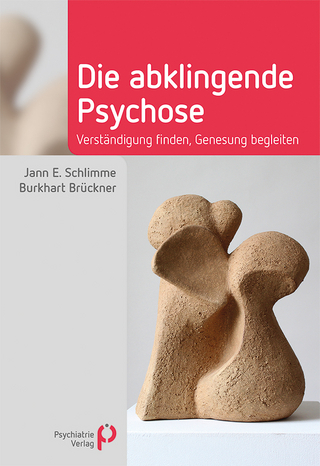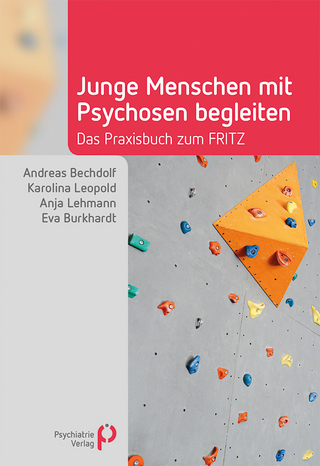
Psychosis, Trauma and Dissociation
Wiley-Blackwell (Verlag)
978-0-470-51173-2 (ISBN)
Psychosis, Trauma and Dissociation is the first book to attempt to reforge this connection, by presenting challenging new findings linking these now disparate fields, and by comprehensively surveying, from a wide range of perspectives, the complex relationship between dissociation and psychosis.
A cutting-edge sourcebook, Psychosis, Trauma and Dissociation brings together highly-respected professionals working in the psychosis field with renowned clinicians and researchers from the fields of traumatic stress, dissociation and the dissociative disorders, and will be of interest to those working with or studying psychotic or dissociative disorders, as well as trauma-related conditions such as borderline personality disorder or complex post-traumatic stress disorder. It makes an invaluable contribution to the burgeoning literature on severe mental disorders and serious life events. The book has three sections:
Connecting trauma and dissociation to psychosis - an exploration of the links between trauma, dissociation and psychosis from a wide range of historical and theoretical perspectives.
Comparing psychotic and dissociative disorders - a presentation of empirical and clinical perspectives on similarities and differences between the two sets of disorders.
Assessing and treating hybrid and boundary conditions - consideration of existing and novel diagnostic categories, such as borderline personality disorder and dissociative psychosis, that blend or border dissociative and psychotic disorders, along with treatment perspectives emphasising humanistic and existential concerns.
Dr. Andrew Moskowitz, Clinical Senior Lecturer, University of Aberdeen, UK Ingo Sch fer, M.D., Klinik f r Psychiatrie und Psychotherapie, Universit tsklinikum Hamburg-Eppendorf, Germany Martin Justin Dorahy, Department of Psychology, University of Canterbury, Christ Church, New Zealand
Foreword xiii
List of contributors xvii
Introduction 1
Andrew Moskowitz, Ingo Schafer and Martin J. Dorahy
PART 1 Connecting trauma and dissociation to psychosis: Historical and theoretical perspectives 7
1 Historical conceptions of dissociation and psychosis: Nineteenth and early twentieth century perspectives on severe psychopathology 9
Warwick Middleton, Martin J. Dorahy and Andrew Moskowitz
1.1 Dissociation: Mesmerism, multiple personalities and hysteria 10
1.2 Psychosis: Insanity, dementia praecox and schizophrenia 12
1.3 Dissociation, psychosis and schizophrenia: The merging of constructs 15
1.4 Conclusion 17
2 Hysterical psychosis: A historical review and empirical evaluation 21
Eliezer Witztum and Onno van der Hart
2.1 Early literature on hysterical psychosis 22
2.2 Hysterical psychosis in Pierre Janet s dissociation theory 22
2.3 The decline of hysteria 24
2.4 The return of the diagnosis of hysterical psychosis 25
2.5 Systematic and empirical studies 27
2.6 Hysterical psychosis and reactive psychosis 28
2.7 Integration and concluding remarks 29
3 Association and dissociation in the historical concept of schizophrenia 35
Andrew Moskowitz
3.1 The birth of schizophrenia 37
3.2 Splitting, dissociation and the unconscious 39
3.3 Complexes and fixed ideas 41
3.4 Loosening of associations 43
3.5 Summary and conclusions 45
4 Ego-fragmentation in schizophrenia: A severe dissociation of self-experience 51
Christian Scharfetter
4.1 Schizophrenic syndromes as self-disorders 52
4.2 The construct of ego-pathology 52
4.3 Clinical elaboration of ego-pathology 53
4.4 Empirical assessment of ego-pathology 57
4.5 Ego-fragmentation, association and the dissociation model 59
4.6 Dissociative mechanisms: What and where? 60
4.7 The continuum of dissociative mechanisms: The spectrum of dissociation 62
5 Delusional atmosphere, the psychotic prodrome and decontextualized memories 65
Andrew Moskowitz, Lynn Nadel, Peter Watts and W. Jake Jacobs
5.1 Multiple memory systems and the hippocampus 66
5.2 Phobias, panic attacks and post-traumatic stress disorder 67
5.3 A summary of relevant research findings in schizophrenia 68
5.4 The psychotic prodrome 70
5.5 Delusional atmosphere, the psychotic prodrome and decontextualized memories 74
5.6 Freud s The Uncanny (1919) 75
5.7 Summary and conclusion 75
6 The complex overlap between dissociation and schizotypy 79
Timo Giesbrecht and Harald Merckelbach
6.1 Introduction 79
6.2 Overlap between measures of dissociation and schizotypy 80
6.3 Why dissociation and schizotypy overlap 81
6.4 Conclusion 85
7 Pierre Janet on hallucinations, paranoia and schizophrenia 91
Andrew Moskowitz, Gerhard Heim, Isabelle Saillot and Vanessa Beavan
7.1 Historical overview 92
7.2 Important Janetian concepts 93
7.3 Schizophrenia 95
7.4 Paranoia 97
7.5 Hallucinations 98
8 From hysteria to chronic relational trauma disorder: The history of borderline personality disorder and its links with dissociation and psychosis 105
Elizabeth Howell
8.1 Historical overview 106
8.2 Theoretical analysis 109
8.3 Summary 113
9 An attachment perspective on schizophrenia: The role of disorganized attachment, dissociation and mentalization 117
Giovanni Liotti and Andrew Gumley
9.1 Attachment disorganization and dissociation 118
9.2 Trauma and loss in the lives of primary caregivers of psychiatric patients 120
9.3 Dissociation, schizotypy and psychotic experiences 122
9.4 Metacognition and mentalization deficits 124
9.5 Summary and theoretical integration 126
9.6 Concluding remarks 127
PART 2 Comparing psychotic and dissociative disorders: Research and clinical perspectives 135
10 Childhood trauma in psychotic and dissociative disorders 137
Ingo Schafer, Colin A. Ross and John Read
10.1 Childhood trauma in patients with psychotic disorders 138
10.2 Childhood trauma in patients with dissociative disorders 141
10.3 The relationship between dissociation and psychosis 142
11 Dissociative symptoms in schizophrenia 151
Ingo Schafer, Volkmar Aderhold, Harald J. Freyberger and Carsten Spitzer
11.1 Empirical studies on dissociation in patients diagnosed with schizophrenia 153
11.2 Dissociation and psychosis what is the relationship? 158
11.3 Conclusion 160
12 Psychotic symptoms in complex dissociative disorders 165
Vedat Sar and Erdinc Ozturk
12.1 Hallucinations 166
12.2 Grossly disorganized behaviour 167
12.3 Impairment in reality-testing: Trance-logic or psychotic breakdown? 168
12.4 Conditions mimicking formal thought disorder 169
12.5 Schneiderian symptoms: Are they nonspecific? 169
12.6 Psychopathogenesis of psychotic symptoms in dissociative disorders 170
12.7 An interaction (duality) model 171
12.8 Conclusions and recommendations for future research 172
13 Advances in assessment: The differential diagnosis of dissociative identity disorder and schizophrenia 177
Marlene Steinberg and Harold D. Siegel
13.1 Dissociative identity disorder and schizophrenia: Overlapping and diagnostically distinct symptoms 178
13.2 Distinguishing between schizophrenia and dissociative identity disorder: Assessment of dissociation 181
13.3 Clinical implications 185
14 Cognitive perspectives on dissociation and psychosis: Differences in the processing of threat? 191
Martin J. Dorahy and Melissa J. Green
14.1 Trauma and threat in dissociative and psychotic individuals 192
14.2 Attention and working memory 194
14.3 Conclusion 201
15 Depersonalization disorder and schizotypal personality disorder 209
Daphne Simeon and Holly K. Hamilton
15.1 Phenomenology of depersonalization and schizotypy 210
15.2 Neurocognitive profiles of depersonalization and schizotypy 211
15.3 Neurobiology of depersonalization and schizotypy 212
15.4 Clinical vignettes 215
15.5 Conclusion 216
16 Contributions of traumatic stress studies to the neurobiology of dissociation and dissociative disorders: Implications for schizophrenia 221
Eric Vermetten, Ruth Lanius and J. Douglas Bremner
16.1 Introduction 221
16.2 Differentiation of abnormal thought processes in dissociative disorders and schizophrenia vignettes 222
16.3 Schizophrenia research: From psychosocial events to traumatic stress 223
16.4 Effects of traumatic stress on psychobiological systems 224
16.5 Pharmacologically induced dissociation 226
16.6 Neurotransmitters in dissociation and psychosis 227
16.7 Different neural circuits in schizophrenia and dissociative disorders 228
16.8 Heterogeneity of trauma response: Neural circuits in dissociative disorders and other trauma-related disorders 230
16.9 Vulnerable phenotypes 231
16.10Concluding remarks 232
17 Treating dissociative and psychotic disorders psychodynamically 239
Valerie Sinason and Ann-Louise S. Silver
17.1 Historical background 240
17.2 Clinical vignettes 242
17.3 Treating dissociative states 248
17.4 The role of trauma in creating psychopathology 249
17.5 Conclusion 251
PART 3 Assessing and treating hybrid and boundary conditions: Clinical and existential perspectives 255
18 Dissociative psychosis: Clinical and theoretical aspects 257
Onno van der Hart and Eliezer Witztum
18.1 Dissociative psychosis and Pierre Janet s dissociation theory 258
18.2 Dissociative psychosis and the theory of structural dissociation of personality 259
18.3 Discussion and conclusion 267
19 Trauma-based dissociative hallucinosis: Diagnosis and treatment 271
Barry Nurcombe, James G. Scott and Mary E. Jessop
19.1 Psychotic symptoms in post-traumatic stress disorder (PTSD) and complex PTSD 272
19.2 Hallucinations in children and adolescents 272
19.3 Clinical vignettes 274
19.4 Dissociative hallucinosis 275
19.5 The treatment of dissociative hallucinosis 276
19.6 Conclusion 277
20 Dissociative schizophrenia 281
Colin A. Ross
20.1 A dissociative structural model of the psyche 283
20.2 The dissociative subtype of schizophrenia 287
20.3 A clinical case example of dissociative schizophrenia 289
20.4 Research data supporting the existence of dissociative schizophrenia 292
20.5 Research and clinical implications of dissociative schizophrenia 293
21 The role of double binds, reality-testing and chronic relational trauma in the genesis and treatment of borderline personality disorder 295
Ruth A. Blizard
21.1 The effects of relational trauma on reality-testing 297
21.2 Caregiver pathology, double binds, disorganized attachment and dissociated self-states 298
21.3 Treating the effects of dissociative, psychotic or sociopathic caregivers on reality-testing 301
21.4 Conclusion: Borderline psychotic traits stemming from relational trauma require relational treatment 303
22 Pharmacotherapy in the collaborative treatment of trauma-induced dissociation and psychosis 307
Thom Rudegeair and Susie Farrelly
22.1 A brief overview of psychopharmacologic philosophy 308
22.2 The complex presentation of people who dissociate 309
22.3 Overview of a good enough medical approach to the treatment of dissociative/psychotic phenomena 310
22.4 Some specific recommendations for the use of psychotropic medications in the treatment of persons with dissociative symptoms 312
22.5 Summary 317
23 Accepting and working with voices: The Maastricht approach 319
Dirk Corstens, Sandra Escher and Marius Romme
23.1 The history of the Maastricht approach and of the hearing voices movement 320
23.2 Relevant research findings 320
23.3 Assessment: The Maastricht hearing voices interview 321
23.4 Formulation: Making the construct/breaking the code 325
23.5 Case vignette: Maureen 327
23.6 Making a treatment plan 328
23.7 Talking with the voices 329
23.8 Recovery 330
23.9 Summary 331
24 Dissociation, psychosis and spirituality: Whose voices are we hearing? 333
Patte Randal, Jim Geekie, Ingo Lambrecht and Melissa Taitimu
24.1 A cosmic battle: Patte s story 335
24.2 Maori perspectives 336
24.3 Shamanic crisis 337
24.4 A cosmic battle Part 2 338
24.5 The subjugation of other cultural perspectives 339
24.6 Dissociation and psychosis as states of consciousness 340
24.7 A cosmic battle Part 3 341
24.8 From victim to victor a new model 342
24.9 Conclusion 343
References 343
Index 347
| Erscheint lt. Verlag | 21.11.2008 |
|---|---|
| Verlagsort | Hoboken |
| Sprache | englisch |
| Maße | 178 x 252 mm |
| Gewicht | 826 g |
| Themenwelt | Geisteswissenschaften ► Psychologie ► Psychosen |
| Geisteswissenschaften ► Psychologie ► Traumatherapie | |
| Medizin / Pharmazie ► Medizinische Fachgebiete ► Psychiatrie / Psychotherapie | |
| ISBN-10 | 0-470-51173-7 / 0470511737 |
| ISBN-13 | 978-0-470-51173-2 / 9780470511732 |
| Zustand | Neuware |
| Haben Sie eine Frage zum Produkt? |
aus dem Bereich


